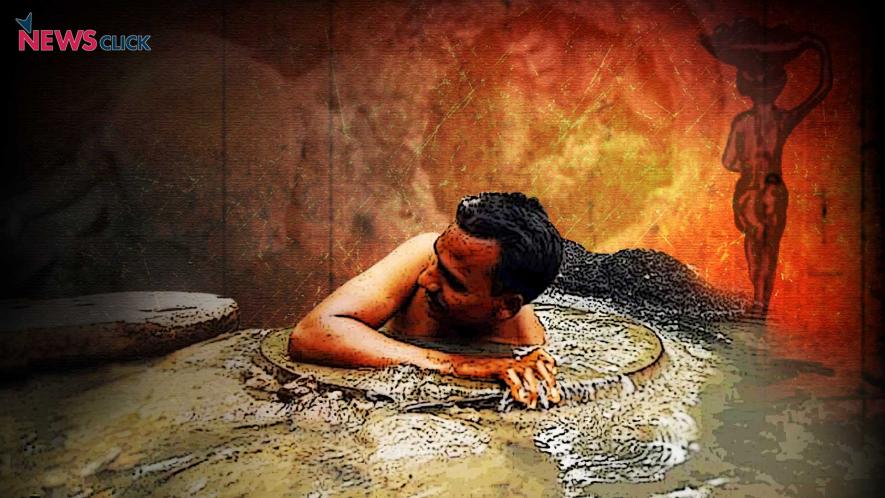The Purity-Impurity Logic of Hindu Caste Mentality is Convoluted

The daily recital of Vedic mantras at our all-boys Arya Samaj school was much resented by students. It was the butt of our jokes, and the more creative among us even developed puns about it. But then there was our social sciences teacher, Mr Vaid, a no-nonsense, staunch Arya Samaji, who commanded silent respect. The old Mr Vaid was always impeccably dressed, he walked with measured steps, and spoke even more measuredly. The deference the boys showed him was primarily due to his wry humour, which could cut any smart alec to size in no time.
Mr Vaid’s one comment about the behaviour of caste Hindus towards those who cleaned their lavatories is still etched in my memory. One day, he entered the classroom looking irritated, and blurted out loudly: “Voh log pass se gujarte hain to yeh naak moonh sukorte hain. Nikamme yah naheen soch sakte ki vohee cheej to din bhar apne pet mein liye ghoomte hain, jiske kaaranh unko neech samajhte hain.” (These people run away from those who clean their shit. Imbeciles do not realise that they themselves carry the same shit inside their stomachs all day.)
The Hindu caste mentality, though, is impervious to the matter of fact reasoning of people like Mr Vaid. When asked to comment on the recent Supreme Court ruling allowing women to enter the Sabarimala temple in Kerala, and the agitation there to stop them from doing so, a woman minister in the Narendra Modi government said: “(It is) just plain common sense. Would you take sanitary napkins seeped in menstrual blood and walk into a friend’s home? You would not. Would you think it is respectful to do the same thing and walk into house of God?” The minister was being too smart for herself (she was apparently reacting to fake news on social media about some women activists threatening to carry sanitary pads inside the temple). Had Mr Vaid been around, he could have responded, “If you are so worried about women carrying blood-soaked pads in their bags, I am sure you actually have notices outside your office and home saying that menstruating women are not allowed. That is precisely what the people opposing Sabarimala judgment want for that temple”.
A human body cannot be alive without blood, as much as after eating, it cannot but carry shit. And every sanitary napkin in use is more or less soaked in blood. Then how come shame, derision, and sacrilege gets attached to things which are integral to our lives?
After a wide-ranging cross-cultural study, anthropologist Mary Douglas found ‘dirt to be matter out of place’. Mr Vaid’s reasoning was one step ahead. It questioned what caste Hindus did after the shit out of body was declared dirt. His reasoning was not a Gandhian appeal to the good conscience of caste Hindus. He was not making any claims about the people despised by caste Hindus, as Gandhi did by christening them ‘the people of God’. His move was Ambedkarite, in the genus of the ‘Annihilation of the Caste’. He puts a mirror to caste Hindus. “You despise people for carrying shit, but look, it is sitting right inside you”. His argument puts two choices before caste Hindus. They can either be consumed by self-hatred, or they could change themselves. If caste Hindus turn away from the mirror put by Mr Vaid’s rationality, it does not change their reality. It only deprives them of an opportunity to see what they are.
The Brahmanical world, both the corporal one in which people live, and the mental ideological one through which they think, is riven by the purity-impurity logic. Human bodily excretions are among the most impure. This impurity is not only metaphysical, it is also social, since it is thrust upon humans. This is the anti-human core of Brahmanism. Manusmriti’s list of impure humans includes chandals (low-caste Hindu people considered untouchables as they dealt with corpses), menstruating women, outcasts, women in childbed and corpses. Think of the bizarre consequences of its multiple loathings. A wailing mother with the body of her dead child in her lap is doubly impure if she happens to be menstruating. Instead of being a human whose grief should be shared, she gets scarred with impurity. Others may wonder, what is it in any woman that the so-called devotees at Sabarimala get so incensed with her presence in the temple? Well, it is not the women, but the ‘devotees’, and ministers of the Republic of India, who have the eyes, the mind and the heart of Manu.
The Dirty Side of Homo Hierarchicus
French anthropologist Louis Dumont developed his model of Hindu society as Homo Hierarchicus on the basis of the purity-impurity divisions created in Sanskrit religious texts. Critics have righty criticised his thesis as a Brahmanical model of caste society because it neglects other castes’ experiences, understandings, or opposition to the caste system. Yet, it cannot be denied that the Brahmanical viewpoint is hegemonic. While the Brahmanic hegemony means that it colours the everyday life of most Hindus, its counters, whether liberal constitutional, Gandhian, or even Dalit, suffer from a serious lacuna.
What caste does to its victims is well known, commented, criticised, or even outlawed (like the Constitution of India did to untouchability), what caste does to its upholders and perpetrators is little understood and explored. This is what Ambedkar does in his undelivered lecture ‘Annihilation of Caste’, which was to be addressed not to his followers, but to caste Hindus. Ambedkar’s analysis and criticism was so damning that even the radical Arya Samaji group ‘Jat Pat Todak Mandal’, which had invited him to deliver the lecture, withdrew its invitation.
Our Prime Minister seriously believes that if the ‘Swachh Bharat’ campaign can make India clean, that at least would be his one true contribution to make India great. He is not wrong, for it is true that Indian public spaces, our fields, village streets, parks, roadsides, area along railway tracks, riverfronts, holy places, or public toilets (including toilets of Air India planes) are among the dirtiest in the world. It is not a question of poverty. India’s rich in fact spread more filth than the poor. Countries poorer than India are often cleaner.
The purity-impurity logic of caste Hindus opens the window to an explanation. Once human excretions are declared to be religiously impure, there is strong aversion to deal with them when they are in the open. Hence, the Hindu society spectacularly failed to develop a social system of collecting, disposing or re-using human waste. ‘Throw out’ is the only rule followed. It is crucial that those on whom the varna division of labour put the responsibility for cleaning private and public spaces were technically outcasts, not even worth being part of the social system.
Comparative examples are always illuminating. American Marxist William Hinton, who spent years in China during and after the 1949 revolution, describes an interesting practice in pre-revolutionary villages in his book, Iron Oxen. There was abject poverty all around, but every farmer would have a hole of a sty near the doorway of his house in which all the waste produced in the house, including human, animal and in the kitchen was dumped. It was kept close to the entrance so that even passersby would deposit their waste.
In the pre-industrial age, and with very few animals, this waste was the only manure available for fields. All farmers of a village planted on the same day. The stinking sludge was pulled out in buckets from every sty on the appointed day. Farmers and their families would wrap themselves in rags for protection from the stink. However, despite the stink they would carefully pour a spoonful of the rich manure in the hole of every sapling. The stink would spread through the air. For miles around, other villagers could smell which village was planting. Hinton, who participated in one such planting, recounts how for months afterwards, he could not get the stink off his hands. Chinese farmers may be doing ‘dirty’ work, but their villages were relatively clean. There are accounts of a similar practice in Ladakh.
Caste and patriarchy dehumanise and violate the dignity of their victims. As our teacher Mr Vaid saw, they also produce modes of behavior and thinking that follow absurd logic. Through hegemonic ideologies, these create a world of social interactions which is bad for everyone. The Hindus of India need to annihilate caste and its patriarchy, not for the sake of Dalits and women, but primarily for their own sake.
(Sanjay Kumar teaches Physics at St Stephen’s College, Delhi.)
Get the latest reports & analysis with people's perspective on Protests, movements & deep analytical videos, discussions of the current affairs in your Telegram app. Subscribe to NewsClick's Telegram channel & get Real-Time updates on stories, as they get published on our website.
























